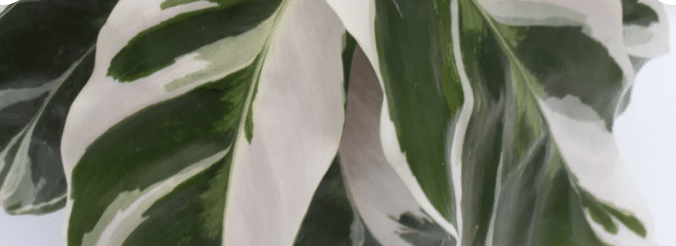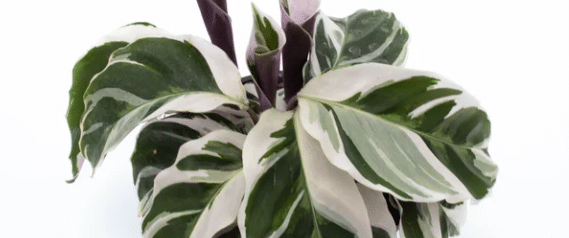If you are looking for a tropical plant to add to your indoors to improve your house looks, consider getting calatheas. These houseplants grow dense and produce abundant foliage bright and unique in their patterns.
They come in different varieties, so you’ll have no problems finding one that suits your taste and preferences. In the wild, calathea plants display brightly-colored and uniquely-shaped blooms, but they rarely flower indoors.
Most of the time, calathea white fusion turns green because of inappropriate lighting
If you like plants that can help you make a statement, the White Fusion cultivar might be the ideal option for your indoors. Also known as the peacock plant (and for the right reasons), this plant displays stunning variegated foliage with green leaves and contrasting white markings.
And if that sounds astonishing enough, it is not all! The undersides of this variety of calathea have a hue of magenta, which makes it even more striking.
It Can Be a Challenge to Grow a Calathea White Fusion

Yes, this plant might be more challenging to grow at first. However, your efforts will be worth it in the end. And once you get the care routine right, your reward will be a unique display of dense and fast-growing foliage.
But poor management can result in discoloration or even the loss of the pattern that makes this plant unique. If you are growing Calathea White Fusion, you’ll need to learn about its requirements. If you see something off with its foliage, there is something wrong with your plant.
Is your Calathea White Fusion turning green? Don’t worry: we are here to help you solve the issue. Here you’ll find everything you must know about preventing discoloration in this stunning houseplant and keeping its leaves’ vibrant patterns.
Why Is Calathea White Fusion Turning Green?
Calathea White Fusion plants are not the easiest plants to grow. However, that doesn’t mean it is impossible to have them thriving in your house. You will have to pay attention to their requirements and provide all they need to grow. And that could be challenging.
But if you notice your plant’s leaves losing their unique variegation, you need to take proper action to reverse it. As you might expect, that might not always be as easy as it sounds.
Most of the time, calathea white fusion turns green because of inappropriate lighting.
Indeed, finding the right level of light for your plant is a challenging task. For best results, avoid bright and direct light.
Instead, place your plant next to a sunny window and consider getting sheer curtains to protect its leaves from the sun. But don’t forget that too much shade can be detrimental too. Finding the ideal balance is crucial, but it might take some time and effort from your side.
Also, some gardeners claim that white fusion plants can revert to their natural all-green appearance. If that’s the case for your plant, you might not be able to cure it.
However, if you notice only a couple of leaves are turning green, you might be able to maintain the plant’s unique looks by propagating healthy-looking stems.
But what can you do to grow your Calathea and recreate its optimal conditions? Jump to the following section to find out! You might be able to avoid problems with your plant turning green.
Calathea White Fusion Care: Our Tips
Besides choosing the ideal location where your plant will get adequate lighting, you must pay attention to other factors to have your Calathea thriving.
For instance, consider using African violet potting mixes to ensure proper water retention and drainage. If you prefer making your substrate, combine lightweight potting mix with orchard bark, perlite, or peat moss.
Because of their native environment, these plants need regular moisture and prefer warm conditions. However, avoid exposing them to extreme temperatures: they won’t survive.
Also, while the soil should be moist, leaving it soggy is a recipe for disaster. Avoid overwatering your plant to prevent severe problems with your calathea, such as root rot and fungal diseases. Ensure you place your plant in a pot with drainage holes to improve water flow.
Feel the soil before adding extra moisture: if it is dry at about two inches, it is time to water your plant. Otherwise, you will have to wait a couple of days more.
Consider adding pebble trays or invest in a humidifier to maintain optimal humidity levels around your plant. Also, don’t forget to remove brown or curled leaves as soon as you spot them to minimize the impact on your plant.
You may also like: Calathea Exotica Growth and Care Guide
